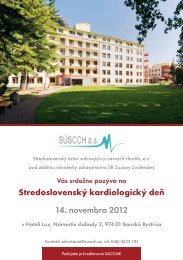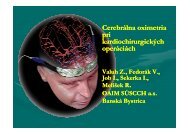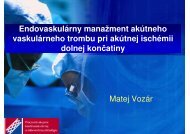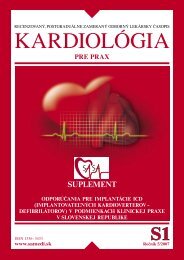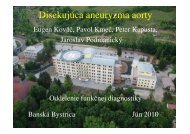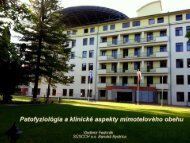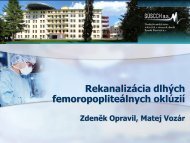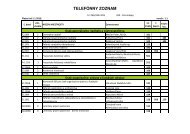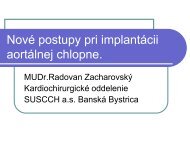Management of acute myocardial infarction in patients presenting ...
Management of acute myocardial infarction in patients presenting ...
Management of acute myocardial infarction in patients presenting ...
Create successful ePaper yourself
Turn your PDF publications into a flip-book with our unique Google optimized e-Paper software.
ESC Guidel<strong>in</strong>es 2925<br />
can be confirmed by echocardiography. Although echocardiography<br />
is not always able to show the site <strong>of</strong> rupture, it can demonstrate<br />
pericardial fluid with or without signs <strong>of</strong> tamponade. The<br />
presence <strong>of</strong> pericardial fluid alone is not sufficient to diagnose a<br />
sub<strong>acute</strong> free wall rupture, because it is relatively common after<br />
<strong>acute</strong> <strong>myocardial</strong> <strong><strong>in</strong>farction</strong>. The typical f<strong>in</strong>d<strong>in</strong>g is an echo-dense<br />
mass <strong>in</strong> the pericardial space consistent with clot (haemopericardium).<br />
Immediate surgery should be considered.<br />
Ventricular septal rupture<br />
The diagnosis <strong>of</strong> ventricular septal rupture, first suspected because<br />
<strong>of</strong> sudden severe cl<strong>in</strong>ical deterioration, is confirmed by the occurrence<br />
<strong>of</strong> a loud systolic murmur, by echocardiography and/or by<br />
detect<strong>in</strong>g an oxygen step-up <strong>in</strong> the right ventricle. Echocardiography<br />
reveals the location and size <strong>of</strong> the ventricular septal defect;<br />
the left-to-right shunt can be depicted by colour Doppler and<br />
further quantified by pulsed Doppler technique. Pharmacological<br />
treatment with vasodilators, such as i.v. nitroglycer<strong>in</strong>e, may<br />
produce some improvement if there is no cardiogenic shock, but<br />
<strong>in</strong>tra-aortic balloon counter pulsation is the most effective<br />
method <strong>of</strong> provid<strong>in</strong>g circulatory support while prepar<strong>in</strong>g for<br />
surgery. Urgent surgery <strong>of</strong>fers the only chance <strong>of</strong> survival for<br />
large post-<strong><strong>in</strong>farction</strong> ventricular septal defect with cardiogenic<br />
shock. 120,121 Even if there is no haemodynamic <strong>in</strong>stability, early<br />
surgery is usually <strong>in</strong>dicated, also because the defect may<br />
<strong>in</strong>crease. 122 However, there is still no consensus on the optimal<br />
tim<strong>in</strong>g <strong>of</strong> surgery as early surgical repair is difficult because <strong>of</strong><br />
friable necrotic tissue. Successful percutaneous closure <strong>of</strong> the<br />
defect has been reported, but more experience is needed before<br />
it can be recommended.<br />
b. Mitral regurgitation<br />
Mitral regurgitation is common and it occurs usually after 2–7<br />
days. There are three mechanisms <strong>of</strong> <strong>acute</strong> mitral regurgitation <strong>in</strong><br />
this sett<strong>in</strong>g: (i) mitral valve annulus dilatation due to LV dilatation<br />
and dysfunction; (ii) papillary muscle dysfunction usually due to<br />
<strong>in</strong>ferior <strong>myocardial</strong> <strong><strong>in</strong>farction</strong>; and (iii) rupture <strong>of</strong> the trunk or tip<br />
<strong>of</strong> the papillary muscle. In most <strong>patients</strong>, <strong>acute</strong> mitral regurgitation<br />
is secondary to papillary muscle dysfunction rather than rupture.<br />
The most frequent cause <strong>of</strong> partial or total papillary muscle<br />
rupture is a small <strong>in</strong>farct <strong>of</strong> the posteromedial papillary muscle <strong>in</strong><br />
the right or circumflex coronary artery distribution. 123 Papillary<br />
muscle rupture typically presents as a sudden haemodynamic<br />
deterioration. Due to the abrupt and severe elevation <strong>of</strong> left atrial<br />
pressure, the murmur is <strong>of</strong>ten <strong>of</strong> low <strong>in</strong>tensity. Chest radiography<br />
shows pulmonary congestion (this may be unilateral). The presence<br />
and severity <strong>of</strong> mitral regurgitation are best assessed by colour<br />
Doppler-echocardiography. Initially, a hyperdynamic left ventricle<br />
can be found. The left atrium is usually <strong>of</strong> normal size or slightly<br />
enlarged. In some <strong>patients</strong>, transoesophageal echocardiography<br />
may be necessary to establish the diagnosis clearly. A pulmonary<br />
artery catheter can be used to guide patient management; the pulmonary<br />
capillary wedge pressure trac<strong>in</strong>g may show large V-waves.<br />
Most <strong>patients</strong> with <strong>acute</strong> mitral regurgitation should be operated<br />
early because they may deteriorate suddenly. Cardiogenic shock<br />
and pulmonary oedema with severe mitral regurgitation require<br />
emergency surgery. Most <strong>patients</strong> need IABP placement dur<strong>in</strong>g<br />
preparation for coronary angiography and surgery.<br />
Valve replacement is the procedure <strong>of</strong> choice for rupture <strong>of</strong> the<br />
papillary muscle, although repair can be attempted <strong>in</strong> selected<br />
cases. 124<br />
4. Arrhythmias and conduction<br />
disturbances <strong>in</strong> the <strong>acute</strong> phase<br />
A life-threaten<strong>in</strong>g arrhythmia, such as ventricular tachycardia (VT), VF,<br />
and total atrio-ventricular (AV) block, may be the first manifestation <strong>of</strong><br />
ischaemia and requires immediate correction. These arrhythmias may<br />
cause many <strong>of</strong> the reported sudden cardiac deaths (SCDs) <strong>in</strong> <strong>patients</strong><br />
with <strong>acute</strong> ischaemic syndromes. VF or susta<strong>in</strong>ed VT has been<br />
reported <strong>in</strong> up to 20% <strong>of</strong> <strong>patients</strong> who present with STEMI. 125<br />
The mechanisms <strong>of</strong> arrhythmias dur<strong>in</strong>g <strong>acute</strong> ischaemia may be<br />
different from those seen <strong>in</strong> chronic stable ischaemic heart disease.<br />
Often arrhythmias are a manifestation <strong>of</strong> a serious underly<strong>in</strong>g disorder,<br />
such as cont<strong>in</strong>u<strong>in</strong>g ischaemia, pump failure, or endogenous<br />
factors such as abnormal potassium levels, autonomic imbalances,<br />
hypoxia, and acid–base disturbances, that may require corrective<br />
measures. The necessity for arrhythmia treatment and its<br />
urgency depend ma<strong>in</strong>ly upon the haemodynamic consequences<br />
<strong>of</strong> the rhythm disorder. Recommendations are given <strong>in</strong> Tables 16<br />
and 17.<br />
a. Ventricular arrhythmias<br />
The <strong>in</strong>cidence <strong>of</strong> VF occurr<strong>in</strong>g with<strong>in</strong> 48 h <strong>of</strong> the onset <strong>of</strong> STEMI<br />
may be decreas<strong>in</strong>g ow<strong>in</strong>g to <strong>in</strong>creased use <strong>of</strong> reperfusion treatment<br />
and b-blockers. 126 VF occurr<strong>in</strong>g early after STEMI has been<br />
associated with an <strong>in</strong>crease <strong>in</strong> <strong>in</strong>-hospital mortality, but not with<br />
<strong>in</strong>creased long-term mortality. The major determ<strong>in</strong>ants <strong>of</strong> risk <strong>of</strong><br />
sudden death are related more to the severity <strong>of</strong> the cardiac<br />
disease and less to the frequency or classification <strong>of</strong> ventricular<br />
arrhythmias. 127,128<br />
Use <strong>of</strong> prophylactic b-blockers <strong>in</strong> the sett<strong>in</strong>g <strong>of</strong> STEMI reduces<br />
the <strong>in</strong>cidence <strong>of</strong> VF. 129 Similarly, correction <strong>of</strong> hypomagnesaemia<br />
and hypokalaemia is encouraged because <strong>of</strong> the potential contribution<br />
<strong>of</strong> electrolyte disturbances to VF. Prophylaxis with lidoca<strong>in</strong>e<br />
may reduce the <strong>in</strong>cidence <strong>of</strong> VF but appears to be associated with<br />
<strong>in</strong>creased mortality probably ow<strong>in</strong>g to bradycardia and asystole,<br />
and has therefore been abandoned. In general, treatment is <strong>in</strong>dicated<br />
to prevent potential morbidity or reduce the risk <strong>of</strong><br />
sudden death. There is no reason to treat asymptomatic ventricular<br />
arrhythmias <strong>in</strong> the absence <strong>of</strong> such potential benefit.<br />
Ventricular ectopic rhythms<br />
Ventricular ectopic beats are common dur<strong>in</strong>g the <strong>in</strong>itial phase. Irrespective<br />
<strong>of</strong> their complexity (multiform QRS complex beats, short<br />
runs <strong>of</strong> ventricular beats, or the R-on-T phenomenon) their value<br />
as predictors <strong>of</strong> VF is questionable. No specific therapy is required.<br />
Ventricular tachycardia and ventricular fibrillation<br />
Neither non-susta<strong>in</strong>ed VT (last<strong>in</strong>g ,30 s) nor accelerated idioventricular<br />
rhythm (usually a harmless consequence <strong>of</strong> reperfusion<br />
with a ventricular rate ,120 bpm) occurr<strong>in</strong>g <strong>in</strong> the sett<strong>in</strong>g <strong>of</strong><br />
STEMI serves as a reliably predictive marker <strong>of</strong> early VF. As such,<br />
these arrhythmias do not require prophylactic antiarrhythmic



